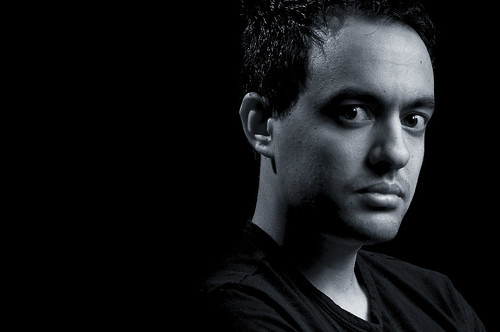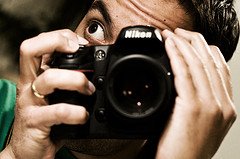Focusing and kicker
When shooting a low-key photo I feel it's important to separate the subject from the background, but not too much, since I at the same time want it to blend with the darkness. So I decided to use a kicker/backlight instead of lighting up the background.
I started by hanging a black piece of fabric on the wardrobe closet. On the photo below you see a pair of scissors on the floor. This marks the position where I would stand. Previously I had placed a light stand on this point and locked the focus on the light stand on the position where my eyes would be. Since I would be using a pretty large aperture, I had some leeway regarding depth of field, and as long as I positioned myself overhead the scissors, the focusing wouldn't represent any problems.
The photo above shows the snooted kicker flash (Nikon SB-600) mounted as high as I could. I made sure that when I stood on the scissors I could see the enitre flash head through the snoot. This would provide lighting for the back of my head.
Main light
On the opposite side of the kicker I set up a light stand with a 45" reflective umbrella with a SB-600. Originally I wanted to try cross-lighting, by sending the the main light parallel with the focal plane, but the first test shot looked so bad. I got a large shadow covering almost 30% of my face, making the portrait a little too low-key'ish. Therefore moved the main light against the camera, so that the umbrella pointed about 20 degrees offset from the imaginary focal plane... Sorry for this complicated description. Thank you, Microsoft Word, who made this illustration possible:
Since I'm looking at the camera, this placement of the umbrella, in addition to emphasizing the shape of the face, also creates catchlights at an approx. two o'clock position.
Exposure
As mentioned, I wanted to use a medium-large aperture to get all of me in focus. I also wanted to use the maximum sync shutter speed to block ambient light. Each flash's ouput was determined by trial and error.
Kicker: 1/128 power, 85mm zoom
Main light: 1/16 power, 24 mm zoom
Exposure: 1/250 sec @ f/8, ISO 200
Lens: Nikkor 50mm f/1.8D AF
Camera: Nikon D300
Shooting and processing
I tried a couple of different poses using a 10 sec timer on the camera. I didn't have a plan in particular, I just kept on shooting until I got a picture with some kind of "drama" in it. After about 10 shots I got this one (untouched RAW file):
After I imported it to Adobe Camera Raw I realized it was under-exposed. It didn't look that way on the LCD-screen on the camera. I had to bump up the exposure to about 1 stop, but luckily no noise was detected.
In Photoshop I increased the contrast in Levels and converted it to black and white with B&W Filter. Cropped it a little. I felt that it needed a little more treatment, so I did something I've never done before: Duotone. I converted it to greyscale mode and then Duotone. I chose a light blue color in addition to black. I probably could have done the same using a color layer or Gradient Maps. Here's the result:
Conclusion:
I should have gotten the right exposure in-camera. I was probably fooled by the dark areas, leaving me to believe that my face was correctly exposed. The next time I'm shooting a low-key portrait I'll use my greycard and histogram again.






1 comment:
Hej.. Nice portrait and thanks for explaining how you took the same
-- Prasanth
ifotoz.blogspot.com
Post a Comment